
 Lepht Anonym, a self-taught British subdermal electronics experimenter calling herself an underground biohacker, takes the floor at 27th Chaos Communication Congress to talk about sensory extension via haptic implants, as well as other things where technology merges with the human body.
Lepht Anonym, a self-taught British subdermal electronics experimenter calling herself an underground biohacker, takes the floor at 27th Chaos Communication Congress to talk about sensory extension via haptic implants, as well as other things where technology merges with the human body.
Hi, first of all forgive me if I sound funny, because I’ve never spoken in a microphone before; also I’ve never seen this many people in one place ever, so I might be a little bit nervous, and I might even pass out. To say a little about stuff that I do for fun, which is not very complex and not very hi-tech, but not many people seem to be into it, so they asked me to do a talk, so I’m doing a talk. It’s probably going to be more of a jabber, but…
 First of all, my name is Lepht, I work with mostly implants, mostly in the field of sensory expansion. I work with adding more data onto the sensory data that you get from real life. It sounds incredibly complex, it’s really not. The whole thing works on one basic principle, that is, your nerves are electric things, and electric devices can set off nerves quite simply.
First of all, my name is Lepht, I work with mostly implants, mostly in the field of sensory expansion. I work with adding more data onto the sensory data that you get from real life. It sounds incredibly complex, it’s really not. The whole thing works on one basic principle, that is, your nerves are electric things, and electric devices can set off nerves quite simply.
I’ll be explaining all of this later; I won’t be giving proper technical instructions, because I don’t actually know the legality of anything like that. Seriously, doctors won’t touch me in England, so if anyone actually wants proper instructions, contact me via email, and I’ll be happy to give you step-by-steps if you want them. It’s really not very difficult, but it hurts a lot, it’s the only thing.
 Ok, a couple of things about me (see right-hand image). I’m not very big, I’m not very clever; all I do is play about with junk. I cut holes in myself, I put things in the holes, the holes are full of electricity and that’s how things work. It’s not complicated at all. That’s my email address there, if anyone wants to contact me, although I should point out, this is why it’s in red – I’m not a doctor; I’m not any kind of doctor, I don’t have anything to do with any medical device ever; please don’t sue me.
Ok, a couple of things about me (see right-hand image). I’m not very big, I’m not very clever; all I do is play about with junk. I cut holes in myself, I put things in the holes, the holes are full of electricity and that’s how things work. It’s not complicated at all. That’s my email address there, if anyone wants to contact me, although I should point out, this is why it’s in red – I’m not a doctor; I’m not any kind of doctor, I don’t have anything to do with any medical device ever; please don’t sue me.
Mostly I work with haptic stuff, that is, devices that work on touch-based, except I’m not really sure if haptic is the right word for any of it, because it’s more like electronic haptics; it’s mostly correct. That’s my crappy blog there, if anyone wants to visit, it has some documentation and mostly whinging.
Mostly they call me a biohacker; this is experimentation on the lowest of low budgets. I have no budget, no money, no anything, so all I work with is stuff that you can get in the kitchen and that you can work with junk, basically. If it’s under 50 Euros – I’ve got it; otherwise – no.
My goal is functional, subdermal electronics. I don’t care about LEDs under people’s skin, I don’t care about stuff that you have to wear. I want proper implanted extensions to human body.
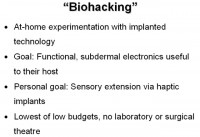 So far this has been mostly successful, with a lot of pain and a lot of side effects, and things like that. My personal goal is sensory extension; there’s a lot of other goals in this field, but mostly they are just goals. As far as I can tell, I’m the only person that actually works with this stuff rather than saying: “I think it would be great if it actually existed.”
So far this has been mostly successful, with a lot of pain and a lot of side effects, and things like that. My personal goal is sensory extension; there’s a lot of other goals in this field, but mostly they are just goals. As far as I can tell, I’m the only person that actually works with this stuff rather than saying: “I think it would be great if it actually existed.”
Although it’s just me, this has a lot of potential for expansion. I’m sort of a start-off point: if other people joined me, it would be a lot better than it is. So, as it said, I am on the lowest of low budgets: I have no money, no surgical theatre, no doctors, no anything; so anything that I can do, you guys can do. If I give you step-by-steps, you’ll definitely be able to follow it.
 Ok, why? Lots of people ask me this all the time. Basically it’s just curiosity, it’s curiosity that is going to kill me one day, because I’ve seen this at the hospital a couple of times. And there’s not many other people working on this, so if I don’t do it, chances are it won’t actually get done, well, up until now, of course – when we’re done here, some of you guys may do things.
Ok, why? Lots of people ask me this all the time. Basically it’s just curiosity, it’s curiosity that is going to kill me one day, because I’ve seen this at the hospital a couple of times. And there’s not many other people working on this, so if I don’t do it, chances are it won’t actually get done, well, up until now, of course – when we’re done here, some of you guys may do things.
They call it “grinding” rather than actual transhumanist technology, because most of transhumanist technology is kind of reserved to laboratories for very, very rich people, and if anyone sees me online, they’ll know that this pisses me off a lot. I hate things that only people with money can afford, so my goal is to get something interesting that extends your sensory perception that you guys can do; something that normal people on a normal person’s budget can follow along with.
 Like I said, anyone can do this. This is just kitchen stuff (see left-hand image). I used to sterilize things with vodka; you can all do this. I have some basic knowledge and some kind of semi-intuitive principles to pass on to you guys, but in the main this is just really a reminder that this exists. It’s kind of common knowledge, or at least I hope it’s common knowledge.
Like I said, anyone can do this. This is just kitchen stuff (see left-hand image). I used to sterilize things with vodka; you can all do this. I have some basic knowledge and some kind of semi-intuitive principles to pass on to you guys, but in the main this is just really a reminder that this exists. It’s kind of common knowledge, or at least I hope it’s common knowledge.
It can be applied to anything you want, anything can be used to stimulate nerves provided that it is subdermal, and it gives off the correct current. You can’t really get wrong, you need any kind of idea. Any device you want to hook up to this can be hooked up. You want a compass – fine, you want a temperature sensor – fine, anything you like. Fundamentally, devices stimulate nerves. All you need to do that is to give off a current. Anything that gives off a current and is safe inside your body can be used as a subdermal device, given some pain. Ok, a lot of pain.
 Health warnings – I have to give you these (see left-hand image). Unfortunately, I’ll take 5 minutes of your time. I’m not a doctor, I’m not a lawyer, I’m not shit. I’m just Lepht. I sit in my kitchen, I cut myself up. There’s a lot of pain in this and a lot of risk. In fact, putting certain things in your fingertips hurts so much you can’t f**king see. So, if you do get involved in this, please make sure you know what you’re doing and you’re ready for pain, because there’s a lot. Anesthesia is not legal in a lot of countries, so please find out what’s legal and what’s not before you do things. Don’t sue me! You still need a bit of money.
Health warnings – I have to give you these (see left-hand image). Unfortunately, I’ll take 5 minutes of your time. I’m not a doctor, I’m not a lawyer, I’m not shit. I’m just Lepht. I sit in my kitchen, I cut myself up. There’s a lot of pain in this and a lot of risk. In fact, putting certain things in your fingertips hurts so much you can’t f**king see. So, if you do get involved in this, please make sure you know what you’re doing and you’re ready for pain, because there’s a lot. Anesthesia is not legal in a lot of countries, so please find out what’s legal and what’s not before you do things. Don’t sue me! You still need a bit of money.
 I would tell you guys a bit about this: self-surgery is a complete last resort. I’ve tried every single doctor in my country before I found out that it’s illegal. You have to ask every expert you can get to first. There’s a guy called Amal Graafstra in the US who has RFID things done – boring, I know, but he had a doctor do it, so some doctors will allow you. Some doctors are bribable; mine are not. British GPs won’t let you do anything, so don’t even bother trying them.
I would tell you guys a bit about this: self-surgery is a complete last resort. I’ve tried every single doctor in my country before I found out that it’s illegal. You have to ask every expert you can get to first. There’s a guy called Amal Graafstra in the US who has RFID things done – boring, I know, but he had a doctor do it, so some doctors will allow you. Some doctors are bribable; mine are not. British GPs won’t let you do anything, so don’t even bother trying them.
And find out what’s going on; read up on infection prevention before you do anything. You’ll need proper tools; you can ask me for where to get yours and what to use, depending on what you’re doing. Anesthesia, wound care, that kind of thing – this is all stuff that you’ll need to do research on if you’re actually going to follow me, which maybe you should.
 This is my main principle: nerve stimulation (see image). Anything can stimulate nerves, as I said. This has been known to medical science for a very long time. As long as you pass current through a nerve, you can set off the nerve. Depending on the strength of the current, this can make the nerve either move muscles, the senses that I have just set off small nerve endings, so you can get sort of tingling sensation, and that’s mostly what you’re looking at.
This is my main principle: nerve stimulation (see image). Anything can stimulate nerves, as I said. This has been known to medical science for a very long time. As long as you pass current through a nerve, you can set off the nerve. Depending on the strength of the current, this can make the nerve either move muscles, the senses that I have just set off small nerve endings, so you can get sort of tingling sensation, and that’s mostly what you’re looking at.
It’s a very, very small current; I’m not sure how small, but it’s enough not to be noticeable anywhere else. Generally, the only place you can do this is the fingertips, because a place has to be quite nerve-rich before this will work. I did try everywhere else, it doesn’t work in the back of your hands, it doesn’t work on the palms of your hands, it doesn’t work on your arms – you’re going to have to put this in the most painful place, basically. You can set off less tense nerves with much higher current, but I’m still experimenting with this, I don’t suggest you do. Leave it to me to f**k myself up with this.
 Natural senses work the exact same way. This is nothing new, this has been done to human body for thousands of years, because your nerves are electronic. Artificial sensors can do this too: I have a bunch of magnetic implants which do precisely that, which is more or less how the principle came across, although don’t think that I invented this, because I didn’t. Those were invented by Steve Haworth. I’ll be talking more about those later.
Natural senses work the exact same way. This is nothing new, this has been done to human body for thousands of years, because your nerves are electronic. Artificial sensors can do this too: I have a bunch of magnetic implants which do precisely that, which is more or less how the principle came across, although don’t think that I invented this, because I didn’t. Those were invented by Steve Haworth. I’ll be talking more about those later.
Anything that is attached to an electrode can be output, so anything can be made into a sensory device. I think I’ve probably said it, like, 5 times now, but I want to get it across. Anything you can fit under your skin and hook up to an electrode can work as an implant, given your propensity for pain.
 Caveats (see left-hand image) – I have to warn you: you’ll need electronics knowledge. I don’t have that, so I have a lot of people online who help me out, and friends who know it. So, it’s useful to have some background of yourself – you’re all hackers, you probably have more than I do.
Caveats (see left-hand image) – I have to warn you: you’ll need electronics knowledge. I don’t have that, so I have a lot of people online who help me out, and friends who know it. So, it’s useful to have some background of yourself – you’re all hackers, you probably have more than I do.
Bioproofing is a whole world of nasty rusty scummy fun. Please make sure that you bioproof things. There’s something you can go by called Sugru – you get it online, it’s moldable silicone rubber, really useful stuff, hopefully works, too. And as I said, please do your legal research.
 Miniaturization, too – I’ve had a lot of problems with that, because a lot of things come on PCBs that won’t actually fit. PCBs themselves are not good for going under your skin, trust me. As I said, if you place it too tightly, sometimes you’ll knock into a corner or something, and everything will come out, and you’ll have to start again.
Miniaturization, too – I’ve had a lot of problems with that, because a lot of things come on PCBs that won’t actually fit. PCBs themselves are not good for going under your skin, trust me. As I said, if you place it too tightly, sometimes you’ll knock into a corner or something, and everything will come out, and you’ll have to start again.
So, be careful of breakage, be careful of society, because that’s pretty much what they do – they just look at you and are like: “What the f**k did you do that for? Ew!” And they all freak out. Stay away from normal people, they’re stupid.
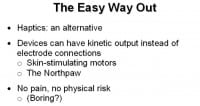 Just as a quick aside, if anyone doesn’t actually want to cut yourselves open for some reason, you can always look into haptics (see right-hand image). My friends at the Sensebridge collective have a website all about this stuff. Haptics is basically no pain, no risk, boring, and it’s to do with external skin stimulation instead of internal. So, it’s not a permanent adaptation; it’s things that you wear. They are much smarter than I am, so their devices are actually production: you can buy a kit. I’m not advertising, it’s just easier than this.
Just as a quick aside, if anyone doesn’t actually want to cut yourselves open for some reason, you can always look into haptics (see right-hand image). My friends at the Sensebridge collective have a website all about this stuff. Haptics is basically no pain, no risk, boring, and it’s to do with external skin stimulation instead of internal. So, it’s not a permanent adaptation; it’s things that you wear. They are much smarter than I am, so their devices are actually production: you can buy a kit. I’m not advertising, it’s just easier than this.
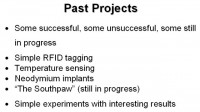 Past projects – these are the ones that I’ve actually done (see image to the left). I’ve messed around with RFID tags, I’ve messed around with temperature sensing, I’ve played a lot with these Neodymium implants. “The Southpaw” is my big project, which I’ll be explaining a little later, because that’s the only thing that is actually cool. As I said, they’re very simple experiments; it’s just that the results are quite interesting. You can apply this to a lot of things that some people don’t seem to think about.
Past projects – these are the ones that I’ve actually done (see image to the left). I’ve messed around with RFID tags, I’ve messed around with temperature sensing, I’ve played a lot with these Neodymium implants. “The Southpaw” is my big project, which I’ll be explaining a little later, because that’s the only thing that is actually cool. As I said, they’re very simple experiments; it’s just that the results are quite interesting. You can apply this to a lot of things that some people don’t seem to think about.
 Ok, fun with RFID is what I’ve been doing for years and years. This was, maybe, three years ago. RFID, radio-frequency identification protocol – you all know this, it’s just simplistic stuff at tagging things (see right-hand image). Obviously, you can tag people. If you’ve just got a simple reader, you can put an ampoule, which is a tiny glass tag for all kinds of things. You can put it inside you, because it’s bioproof, and you can track yourself.
Ok, fun with RFID is what I’ve been doing for years and years. This was, maybe, three years ago. RFID, radio-frequency identification protocol – you all know this, it’s just simplistic stuff at tagging things (see right-hand image). Obviously, you can tag people. If you’ve just got a simple reader, you can put an ampoule, which is a tiny glass tag for all kinds of things. You can put it inside you, because it’s bioproof, and you can track yourself.
 I had a keyboard running that wouldn’t let anyone log on to Windows or Linux unless it was actually me present there (see left-hand image), but as you all know, I know you’re thinking it’s so easy to break – yeah, it is. Boring… You don’t really need to implant yourself with this stuff at all. I just did it for kicks, it’s just an interesting little toy to play with, if the surgical procedure is just a scalpel, really.
I had a keyboard running that wouldn’t let anyone log on to Windows or Linux unless it was actually me present there (see left-hand image), but as you all know, I know you’re thinking it’s so easy to break – yeah, it is. Boring… You don’t really need to implant yourself with this stuff at all. I just did it for kicks, it’s just an interesting little toy to play with, if the surgical procedure is just a scalpel, really.
Anything can be put under your skin. All you need to do is get deep enough to open up a little hole and you can put things in; it’s really simple. If anyone wants to know precisely how I did this, all of these hacks with RFID are all in Amal Graafstra’s book. It’s called “RFID Toys”, but that has step-by-steps. It’s all online, talking about how I did pretty much everything, with some variations, obviously, because mine are subdermal.
 RFID is crap for security, don’t even bother thinking about using it as your main security thing. It’s a cute little “Hey, look what I can do” thing, but it’s really not good. It’s so easy to clone, and you can use it as an extra layer on top of your existing security system, but don’t think about using it for securing anything. It’s just the easiest thing to play with – if you want to figure out some little things about just the principles of experimentation with surgery, then RFID is the thing for you, or you can ask me.
RFID is crap for security, don’t even bother thinking about using it as your main security thing. It’s a cute little “Hey, look what I can do” thing, but it’s really not good. It’s so easy to clone, and you can use it as an extra layer on top of your existing security system, but don’t think about using it for securing anything. It’s just the easiest thing to play with – if you want to figure out some little things about just the principles of experimentation with surgery, then RFID is the thing for you, or you can ask me.
 Overall outcomes – I didn’t really get much out of this other than some simplistic kicks; mostly I got a whole bunch of weebly bleebly about the mark of the beast; apparently I’m a disciple of Satan and all kinds of things. There’s a whole Tagged community for people doing interesting things with the chips, but it’s not really my thing. Like I said, there is a book out there that has all the information, RFID is really well documented; this is probably the only thing I do that actually has extensive documentation.
Overall outcomes – I didn’t really get much out of this other than some simplistic kicks; mostly I got a whole bunch of weebly bleebly about the mark of the beast; apparently I’m a disciple of Satan and all kinds of things. There’s a whole Tagged community for people doing interesting things with the chips, but it’s not really my thing. Like I said, there is a book out there that has all the information, RFID is really well documented; this is probably the only thing I do that actually has extensive documentation.
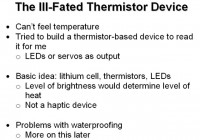 I’m on a lot of medications, as you can probably tell, so one of the side effects is occasionally my sense of temperature just blips in and out of existence. At some point I got bored and decided to build a thermistor-based input device to read this for me, because, well, who wouldn’t? It was very simple: you just hook thermistors up to resistors, up to a battery with an induction coil, and you hook that up to some LEDs or whatever – really simple, just a little circuit (see right-hand image). But I didn’t have enough electronics knowledge to do that, as I will explain later. It would have worked, but it didn’t.
I’m on a lot of medications, as you can probably tell, so one of the side effects is occasionally my sense of temperature just blips in and out of existence. At some point I got bored and decided to build a thermistor-based input device to read this for me, because, well, who wouldn’t? It was very simple: you just hook thermistors up to resistors, up to a battery with an induction coil, and you hook that up to some LEDs or whatever – really simple, just a little circuit (see right-hand image). But I didn’t have enough electronics knowledge to do that, as I will explain later. It would have worked, but it didn’t.
Basic idea was just, like I said, a lithium cell attached to thermistors attached to LEDs. Level of brightness or level of haptic stimulation would determine the level of heat. Could have been a haptic device, could have been a visual device, could have been whatever you wanted. Mostly, from this I learned how to waterproof things, which I’ll explain to you guys later, because it was knowledge hard earned.
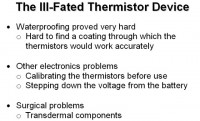 The waterproofing, before I discovered this Sugru stuff, was almost impossible to figure out. I couldn’t find anything that would stay intact inside the human body. I couldn’t find anything that wouldn’t be degraded by natural enzymes or whatever, especially some small devices like thermistors that would actually work. And there were other things like calibrating the damn things, stepping down the voltage so that it didn’t actually shock me when I put it in my hand, all kinds of things.
The waterproofing, before I discovered this Sugru stuff, was almost impossible to figure out. I couldn’t find anything that would stay intact inside the human body. I couldn’t find anything that wouldn’t be degraded by natural enzymes or whatever, especially some small devices like thermistors that would actually work. And there were other things like calibrating the damn things, stepping down the voltage so that it didn’t actually shock me when I put it in my hand, all kinds of things.
At this point it was a transdermal thing, and I would like to say to all of you: if you’re considering anything, got any projects – please put them completely under the skin; don’t think of having things hanging out, because it goes so wrong so fast. It’s bad; it gets stinky and nasty and bad.
 Lessons learned – if it’s waterproof, it’s not necessarily bioproof; trust me on this one. Just because you can leave it in the bath for three days doesn’t mean it’s fine inside your hand. You have to test things, or let me test them. Transdermal implants – bad idea; nasty, stinky, sepsis – bad. It’s almost impossible to keep them clean. Also I learned a lot about basic electronics from this that you guys probably already knew. By the time I gave up on this stupid project, the sense came back and now it’s gone again, so go figure. So many experiments, and you don’t learn anything.
Lessons learned – if it’s waterproof, it’s not necessarily bioproof; trust me on this one. Just because you can leave it in the bath for three days doesn’t mean it’s fine inside your hand. You have to test things, or let me test them. Transdermal implants – bad idea; nasty, stinky, sepsis – bad. It’s almost impossible to keep them clean. Also I learned a lot about basic electronics from this that you guys probably already knew. By the time I gave up on this stupid project, the sense came back and now it’s gone again, so go figure. So many experiments, and you don’t learn anything.
 These things (see right-hand image), I actually can show you how to do these things. Basically, they’re not my invention, I don’t want anyone thinking that I invented these things, because Steve Haworth did in Arizona, and he wants 50 Euros per implant and 150 to put them inside you, which is why I’m here, because I want to tell you how to do it for free. That’s the raw cost, that’s the cost of getting the implant simple. But if you want something professional, you can get a new sense, all 6 of them for all of your savings. Do consider Steve Haworth as an alternative.
These things (see right-hand image), I actually can show you how to do these things. Basically, they’re not my invention, I don’t want anyone thinking that I invented these things, because Steve Haworth did in Arizona, and he wants 50 Euros per implant and 150 to put them inside you, which is why I’m here, because I want to tell you how to do it for free. That’s the raw cost, that’s the cost of getting the implant simple. But if you want something professional, you can get a new sense, all 6 of them for all of your savings. Do consider Steve Haworth as an alternative.
I had some – 2, I think – fitted professionally, and I decided that these cost too much money. Basically they act as a sensory extension, like I was telling you before. The tiny magnets, when they come into contact with electromagnetic field, they resonate and generate electricity of their own, which, obviously, because they’re in your fingertips, sets off nerves. So, when you come into contact with any kind of device field, any power lines in the walls, things on a socket, CD-ROMs, hard drives, anything like that, then they get it off. It’s just a sensory extension, a cute little one; not particularly useful, so please don’t go thinking this will make you a cyberman or something, because it’s just for kicks, really. It’s just an extra layer of data on top of the data you’ve already got. But they’re easy to make and you can do it yourself.
 First thing I had to do was figure out how to get these things inside me by myself, which is actually quite hard (see left-hand image). You can’t have piercers do it in most places anymore. In Amsterdam and Norway this is still legal, so if you want to go do it professionally, do it there. But you can’t do it in France, you can sort of do it in Germany, but you have to be in a piercing studio. There’s lots and lots of problems with doing this at any kind of professional level, so I figured it was much better to do it by myself.
First thing I had to do was figure out how to get these things inside me by myself, which is actually quite hard (see left-hand image). You can’t have piercers do it in most places anymore. In Amsterdam and Norway this is still legal, so if you want to go do it professionally, do it there. But you can’t do it in France, you can sort of do it in Germany, but you have to be in a piercing studio. There’s lots and lots of problems with doing this at any kind of professional level, so I figured it was much better to do it by myself.
So, I sat down in my kitchen with a vegetable peeler, and I decided to put things in my hands. The first time I ever did this, it went horribly, horribly wrong. The whole thing went septic, and I put myself in a hospital for two weeks. It was not very pretty, so lesson learned: sterilize everything. Sterilize everything with vodka if you have to, but make sure you get everything.
There were two or three attempts that have so far been successful; I still need one more to go. It’s really not a difficult procedure; I’ll be telling you precisely how to do it later on. But, as I said, that horrible failure was pretty goddamn horrible, and I learned a lot from that; mostly just simple stuff, like: “Get surgery over with as quickly as possible, because you’re not very coherent during it,” and where to find veins in your hands – just shine a torch through them so that you don’t hit an artery and bleed out and have to get taken down to the hospital, because it’s bad.
Delicate components – a number of times I snicked things covered in silicone and then had them rust inside. If anything snicked at all if you’ve chipped it or dropped it on the floor, whatever – don’t use it, because they do rust so badly, even if you can’t see the cut yourself. Things like spotters – you always need a spotter with you, always, because you will pass out even if you think you’re hardcore. And you need to use proper tools. Don’t use a scalpel for anything in your fingertips – it’s too painful and you won’t be able to do it. Use a big ass 5mm needle instead; I hope you like needles.
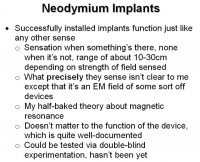 Successfully installed implants just function like any other sense you’ve got. They’re just there in the background. They’re not intrusive; they just set off when something’s there; they don’t when it’s not. Depending on how strong the field is… There’s an MRI lab in my university that I can feel from about 2 meters away.
Successfully installed implants just function like any other sense you’ve got. They’re just there in the background. They’re not intrusive; they just set off when something’s there; they don’t when it’s not. Depending on how strong the field is… There’s an MRI lab in my university that I can feel from about 2 meters away.
It’s just like an interesting local range sense. What precisely this sense is, I don’t know. It’s some kind of EM field, it comes off devices, it comes off power lines; I don’t know exactly what it is; some of you probably will, because I’m not very bright. Like I said, that’s my half-baked theory about magnetic resonance: when you come into contact with fields, the magnets resonate and generate electricity. I don’t know if that’s right; it’s probably not. Max Planck would probably choke me for saying that. But it doesn’t matter to the function device; they work no matter how well you know them. They work if you don’t know they’re there. Could be tested via double blind; hasn’t been tested yet; would accept any testing.
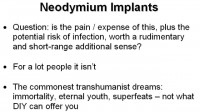 Lots of people ask me: “Is this actually worth it?” The sense is rudimentary, it’s short-range, it’s very, very crude. If curiosity is not your thing, please don’t go doing this to yourself, because it’s not for lots of people. Most transhumanists’ dreams are all about immortality and eternal youth, and wanting to become superman, and wanting to walk up the walls like Spider-Man and stuff, and it’s just not going to happen. This is very crude, very hacky transhumanism. If you want eternal life, you need to go bother somebody else.
Lots of people ask me: “Is this actually worth it?” The sense is rudimentary, it’s short-range, it’s very, very crude. If curiosity is not your thing, please don’t go doing this to yourself, because it’s not for lots of people. Most transhumanists’ dreams are all about immortality and eternal youth, and wanting to become superman, and wanting to walk up the walls like Spider-Man and stuff, and it’s just not going to happen. This is very crude, very hacky transhumanism. If you want eternal life, you need to go bother somebody else.
 Second part of working with these things was that the components themselves, as I said, are actually very expensive. They’re coated in medical-grade silicone, they’re made of various magnets, they’re coated in gold as well – they’re not cheap to get. I’ve actually spent all of my grant on one set of them. The official ones you can only get from Haworth or from his supplier, so, 2 places. They’re like unobtainium; they’re pretty much impossible to get hold of (see right-hand image).
Second part of working with these things was that the components themselves, as I said, are actually very expensive. They’re coated in medical-grade silicone, they’re made of various magnets, they’re coated in gold as well – they’re not cheap to get. I’ve actually spent all of my grant on one set of them. The official ones you can only get from Haworth or from his supplier, so, 2 places. They’re like unobtainium; they’re pretty much impossible to get hold of (see right-hand image).
The import rules are weird on them, and you get taxed, like, 20% of the value, and it’s just not worth trying to get these things to a country where they are not made. But the component is very simple – it’s just neodymium, which you can buy on mass, non-coated. The problem is the coating of gold and silicone.
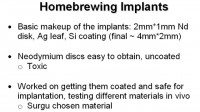 And so, somebody showed me: if you google “neodymium magnet discs” you can get 4 or 5 industrial suppliers. You can buy a bag of these things for the price of Haworth’s one. So, all you have to do is basically mimic what these guys are, and they’re tiny little 2mm wide, 1mm deep neodymium disc coated in gold leaf – not necessarily coated in medical silicone. So, the final is about 4mm by 2mm, and, like I said, they’re very easy to obtain uncoated. But they’re toxic; they’re really, really toxic. Don’t put them in your fingers raw. They need coating, because they’ll poison the crap out of you.
And so, somebody showed me: if you google “neodymium magnet discs” you can get 4 or 5 industrial suppliers. You can buy a bag of these things for the price of Haworth’s one. So, all you have to do is basically mimic what these guys are, and they’re tiny little 2mm wide, 1mm deep neodymium disc coated in gold leaf – not necessarily coated in medical silicone. So, the final is about 4mm by 2mm, and, like I said, they’re very easy to obtain uncoated. But they’re toxic; they’re really, really toxic. Don’t put them in your fingers raw. They need coating, because they’ll poison the crap out of you.
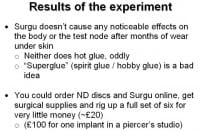 So, I was working on finding a way to coat them in a material that will coat them properly, that you can get without using injection mold, that you guys could take out of a packet in your kitchen and use. Finally I found one, which is what somebody else showed me online. It’s called Sugru. If you google this, you can buy this in little packets. It’s really strange, it’s like moldable silicone rubber, like play-doh that hardens into silicone. So, if you buy this stuff, obviously, really easily you can just coat stuff up. You can coat whatever the hell you like.
So, I was working on finding a way to coat them in a material that will coat them properly, that you can get without using injection mold, that you guys could take out of a packet in your kitchen and use. Finally I found one, which is what somebody else showed me online. It’s called Sugru. If you google this, you can buy this in little packets. It’s really strange, it’s like moldable silicone rubber, like play-doh that hardens into silicone. So, if you buy this stuff, obviously, really easily you can just coat stuff up. You can coat whatever the hell you like.
I’ve tested loads of it on neodymium; I’ve tested loads of it just plain in the body. I’ve got lumps of it that have been there for 6 or 7 months. It’s completely non-toxic, it doesn’t do anything, and if you can’t get hold of Sugru, you can also use hot glue from a glue gun, because it’s the same thing. Lots of things inside me are coated in hot glue gun glue, because it just seems like sort of a perfect bioproofer.
Superglue – bad idea. I’ve tried this before and I almost lost a fingertip; don’t do it. You may think it’s the same thing, but it’s not. You can order the discs and some Sugru online, get some needles and some sterilization gear and a friend to help you out. You can do the whole thing for maybe 20-40 quid; that’s 6 implants and a lot of pain at once. But if you do it all at once, it will be very cost effective. Like I said, it costs about 100 quid. You could maybe get 1 for 100 quid in a piercing studio, and then you have to find a piercer to get it, because they don’t do anything like this anymore. There’s one guy in Germany here in Mannheim that does it, but that’s about it. So, like I said, if anyone wants complete instructions for this, I can give it to you, I’m just not sure whether I’m allowed to give it to you here, so email me.
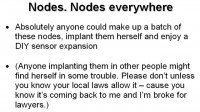 You’ll probably get the procedure just from what I’ve said, anyone can do this. Absolutely anyone can make a whole batch of these things and give them to everyone, except I think that’s illegal, so don’t. Please don’t put them in anyone else, because a friend of mine got into real trouble for that. You can put them in yourself, you can be your own guinea pig, but I think having other people as guinea pigs makes you kind of a mad scientist, so don’t. Just check your local laws first (see image above).
You’ll probably get the procedure just from what I’ve said, anyone can do this. Absolutely anyone can make a whole batch of these things and give them to everyone, except I think that’s illegal, so don’t. Please don’t put them in anyone else, because a friend of mine got into real trouble for that. You can put them in yourself, you can be your own guinea pig, but I think having other people as guinea pigs makes you kind of a mad scientist, so don’t. Just check your local laws first (see image above).
 This one was pretty much one of my most successful experiments, it’s the only one that I finished. I learned how to do the entire procedure, so I can give step-by-steps to anyone who wants it. I know how to manufacture the implants on actual budget rather than ridiculous gold leaf budget. I know everything about aftercare. These things are pretty much a success. I just wish people would sort of like them. The only thing is that they feel kind of nasty for about 2 weeks after you put them in, so do expect some grossness, because it’s really nasty. Like I said, just email me if you actually want step-by-steps.
This one was pretty much one of my most successful experiments, it’s the only one that I finished. I learned how to do the entire procedure, so I can give step-by-steps to anyone who wants it. I know how to manufacture the implants on actual budget rather than ridiculous gold leaf budget. I know everything about aftercare. These things are pretty much a success. I just wish people would sort of like them. The only thing is that they feel kind of nasty for about 2 weeks after you put them in, so do expect some grossness, because it’s really nasty. Like I said, just email me if you actually want step-by-steps.
 The Sensebridge hackerspace – they’re a couple of colleagues of mine – have the Northpaw, which is a haptic compass I’ve talked about earlier. It’s just attached to a PCB, and the PCB senses compass directions through a little compass module. It’s attached to some motor, which you wear on an anklet around your ankle. Whenever the sensor is facing north, the thing buzzes north (see right-hand image).
The Sensebridge hackerspace – they’re a couple of colleagues of mine – have the Northpaw, which is a haptic compass I’ve talked about earlier. It’s just attached to a PCB, and the PCB senses compass directions through a little compass module. It’s attached to some motor, which you wear on an anklet around your ankle. Whenever the sensor is facing north, the thing buzzes north (see right-hand image).
Very interesting concept, but I don’t like wearable stuff; I like subdermal stuff, so I decided to make a proper subdermal version. I bought a Northpaw and started trying to figure out how you would make this thing subdermal. I don’t know whether the word “haptic” is still appropriate, but it is a constant compass. This thing, if you wear it, is a constant sensor of which way is North, and if you implanted it, it would be a proper sensor of which way is north. It turned out to be a hell of a lot more complex than I actually imagined. I figured that you could just take a Northpaw, coat it up and put it in – and that’s not how it works at all. For a start, everything’s too big; for another thing, you can’t actually use motors – there’s no point using motors inside the skin, because that’s silly, you could just use electrodes.
 Ok, so the Northpaw itself: Sensebridge built a custom PCB that runs it, but the whole thing just takes data in from a compass module, powers it via battery pack, uses a ring of servos, and it’s all held in place with this fabric anklet. You get it in a kit, you build it yourself, it’s pretty cool (see left-hand image).
Ok, so the Northpaw itself: Sensebridge built a custom PCB that runs it, but the whole thing just takes data in from a compass module, powers it via battery pack, uses a ring of servos, and it’s all held in place with this fabric anklet. You get it in a kit, you build it yourself, it’s pretty cool (see left-hand image).
It’s well tested, so the actual principle works quite well. Quinn Norton’s got one, it’s been in H+ Magazine, it’s been out for about 2 years, it’s very well known. Southpaw, which is what mine would be called, is the same thing, it’s just different hardware. So, these haptic senses have been around for a really long time.
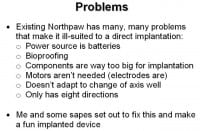 Existing Northpaw – you can’t just chuck it in: there’s batteries that it runs on, which is a bad idea to have those inside you. You have to think about bioproofing; everything is way too big. Like I said, motors are kind of stupid, because it’s just using a middleman, you really need electrodes under the skin. It doesn’t adapt to change of axis, so if you put your hand the other way, it won’t tell you which one is north anymore. It will be still pointing north as if you were walking directly. That needs fixing, but that’s not a problem, because you’ve got a microprocessor. And it only has 8 directions, which is kind of crap.
Existing Northpaw – you can’t just chuck it in: there’s batteries that it runs on, which is a bad idea to have those inside you. You have to think about bioproofing; everything is way too big. Like I said, motors are kind of stupid, because it’s just using a middleman, you really need electrodes under the skin. It doesn’t adapt to change of axis, so if you put your hand the other way, it won’t tell you which one is north anymore. It will be still pointing north as if you were walking directly. That needs fixing, but that’s not a problem, because you’ve got a microprocessor. And it only has 8 directions, which is kind of crap.
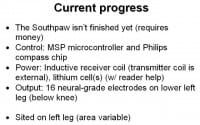 So, me and some people set out to fix this and make it not only better, but more of an implanted device (see left-hand image). It is just for fun, it’s not finished yet. Like I said, my control uses a much smaller microcontroller rather than a custom PCB, because I’m smart enough for that.
So, me and some people set out to fix this and make it not only better, but more of an implanted device (see left-hand image). It is just for fun, it’s not finished yet. Like I said, my control uses a much smaller microcontroller rather than a custom PCB, because I’m smart enough for that.
I use this little tiny 2mm by 3mm MSP microcontroller. Philips compass chip is a little bit bigger; I’m still trying to find a miniature version of that, but at a pinch a normal one could fit, too. It uses inductive receiver coil; transmitter coil is external to it, so you can charge it overnight while it’s still inside you. Lithium cells – I didn’t work out the coil by myself, somebody else helped me, I don’t know if they’re even here or not, but that wasn’t me; I’m not smart enough for that shit. Output is 16 neural-grade electrodes on your lower left leg – could be on your right leg as well. Mine’s on the left leg. Like I said, it could be anywhere you want. It’s just better on a leg, because that tends to be more of a stable axis.
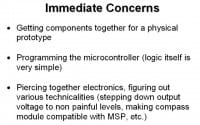 My immediate concerns (see image to the right) are more about getting components rather than figuring out blueprints, because I know what I’m going to do, I just don’t quite have the money to do it yet. So, if anyone wants to catch up and do this instead of me, go ahead. Piecing together electronics – I’ve been doing that, I’ve been figuring out how to not shock myself with it, figuring out how to work the power transfer, all kinds of things; figuring how to keep the coil stable inside your body – it’s quite difficult also. It turns out all you have to do is make more stable cuts.
My immediate concerns (see image to the right) are more about getting components rather than figuring out blueprints, because I know what I’m going to do, I just don’t quite have the money to do it yet. So, if anyone wants to catch up and do this instead of me, go ahead. Piecing together electronics – I’ve been doing that, I’ve been figuring out how to not shock myself with it, figuring out how to work the power transfer, all kinds of things; figuring how to keep the coil stable inside your body – it’s quite difficult also. It turns out all you have to do is make more stable cuts.
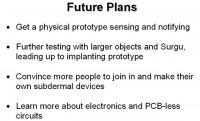 Regarding future plans, well, they’re not really future, they’re more like immediate future, but I need to get a physical prototype working before anything else. The programming side of it is really not very hard: all it has to do is taking data and putting it out correspondently, but it needs testing.
Regarding future plans, well, they’re not really future, they’re more like immediate future, but I need to get a physical prototype working before anything else. The programming side of it is really not very hard: all it has to do is taking data and putting it out correspondently, but it needs testing.
Larger objects and Sugru: I’ve tested a lot of large things, but never altogether, so I don’t know how lots of implants in one area are actually going to go together. This is all very experimental. I need more people to join in also, because I’m quite bored of this just being me. If anyone wants to join in… Also I need to learn a lot more about electronics, because all this stuff I know involves a PCB, and that’s really not practical inside you.
 You could do this better than I can, pretty much all of you. You’re all hackers; I’m not a real hacker, I just do things like cutting myself up and stuff, but somebody with an actual real-world experience at electronics will be able to do really well at this. You just need to know what to use for coatings and what to put where. This is really not difficult knowledge, so people with better brains would be able to do better projects than me. It’s just that nobody does so far; probably because of the self-harm, but whatever, it’s not self-harm if it does something.
You could do this better than I can, pretty much all of you. You’re all hackers; I’m not a real hacker, I just do things like cutting myself up and stuff, but somebody with an actual real-world experience at electronics will be able to do really well at this. You just need to know what to use for coatings and what to put where. This is really not difficult knowledge, so people with better brains would be able to do better projects than me. It’s just that nobody does so far; probably because of the self-harm, but whatever, it’s not self-harm if it does something.
Anyway, that’s about everything, so ask me questions.
Conference Host: So, after all of these very well advised warnings about doing this, raise your hand if you still want to give this a try.
 Question: Two questions. One: how easy is it to get hold of local anesthetics?
Question: Two questions. One: how easy is it to get hold of local anesthetics?
Lepht: Not very.
Question: And two: what repression have you come under in Britain, for example, from doctors? Have they tried to remove the implants from you?
Lepht: No, they’ve advised that I have them removed, but they can’t actually make you do anything. They refuse to treat any medical problems that have anything to do with the implants, because it’s self-inflicted, so you’ll run into a lot of bullshit, but no one will actually stop you from doing it. Also, asking about getting hold of local anesthetics, you mean any good anesthetics, you mean anything that ends in …caine? Almost impossible.
You can buy lidocaine powder online, but I don’t know how to make it up. There’s no instructions online. I managed to find one set of instructions on some survival website about how to mix it up properly, but that’s the problem: if you dose it up too much, you can give yourself a heart attack, so you really need to get the right dosage, and I’ve never been able to. Also, some medical colleague informed me that sometimes it doesn’t work on your hands, so I don’t even know. I just do everything without; if you ice everything up, it’s not that bad. Ok, it is, but it’s worth it.
Question: Ok, first – I think you are a hacker, you hack stuff. And the question is, what legal and what medical precautions do you suggest – immunization or something?
Lepht: No, nothing like immunization. I just suggest finding out what’s legal to do and what’s not, because working on yourself you’re completely fine. I don’t know if that’s illegal in any country. It’s just that doing things on other people is usually completely no-go. For example, in England me doing this to any of you guys leads to 10 years in prison for mutilation with intent to scar, so I wouldn’t if I were you. Just do it on yourself. It’s usually fine on yourself, but be sure to check it.
Question: And insurance? Like med insurance – is there some difference?
Lepht: No, insurance won’t cover this, not ever.
Question: First of all, you scare me shitless, but you also make me curious. First thing: medical people can grow your own skin and implant it. Did you ever think about finding someone who grows skin around the sensor and can then have it implanted?
Lepht: It’s not really necessary. You can put just about anything under your skin if you peel back enough.
Question: Yes, but it’s under it, and you could grow it right into the skin.
Lepht: Yeah, but the problem of rejection: you’d have just as much hassle trying to put that in as you would trying to put it in the old school way. I don’t think that would actually help you. Besides, that’s another thing that you need actually access to a lab for, and all I’ve got is a kitchen.
Question: Ok, may I do another question? You use sensory input that’s already used for heat and pressure…
Lepht: Yeah, I just use standard sensory devices.
Question: Do the new devices affect your heat and pressure feeling?
Lepht: No. Because the physical devices are inside my fingertips, if you touch surfaces sometimes it’s strange if they are magnetic, because the implants will be attracted to the surface. But nothing’s f**ked up, they don’t mess up my touch or pressure senses or anything. They just function as extras, rather than anything that can get in the way.
Question: I have one question about having multiple magnets. Does that mean you can spatially feel a magnetic field as more than one dimension?
Lepht: Yeah, you can tell how big it is and how far it extends. You can even feel it getting weaker towards the edges. You can draw a picture of it, if I could draw. It’s pretty precise.
Question: There are some questions from the peace missions. The first question is: are worried about being owned, or that stuff you implanted could be exploited?
Lepht: Well, I try to make everything GPL, any software. I’m GPL. I don’t care if I get GPL’ed, but I’m trying very hard to make everything open. I didn’t actually want to show my face today, because I wanted this to be just public information rather than coming from me. So, hopefully it’s not linked enough to me for me to be controlled at all.
Question: And here’s the other question: you’ve already told us that you stick this stuff in some silicones. But how do you attach it internally?
Lepht: You don’t need to. Usually there’s very few places in the body where it’ll migrate. If you put things in the back of the hands, they move around, but not very much. So, generally, you don’t need to attach things, they just sit in tissue and stay there. It sounds kind of counterintuitive: you think it will move all over your body, but it doesn’t; it just sits where it’s put.
Question: How has your life changed? You talked about hacking just for the hacking purpose. But is it worth it? Are you doing it to improve our lives and stuff?
Lepht: I’d say it’s worth it to just satisfy your curiosity, but apart from that, it hasn’t really changed anything. You wouldn’t know I had modifications if I didn’t tell you, so I’m not sure it really changes anything at all. All it does is make me more curious. I mean, by the time I’m done you’ll probably be able to tell, because, obviously, my leg will look really messed up by the time this Southpaw is done. But so far – not much, really. I’m still as curious as I ever was.
Question: I’m a software guy. I’m scared shitless by hardware, because 2 years ago I ruined a drone and it had to be taken apart. When software fails, I can just recompile it. When hardware fails, it needs to be taken apart. Where does your total disregard for your own wetware come from? Can you try to justify that?
Lepht: Mine’s just not important. Health takes a big f**k off second seat to curiosity. It’s just not important. You probably shouldn’t be applauding to that guys. That’s not healthy.




























